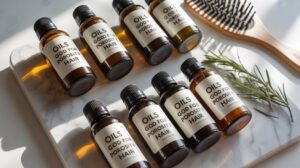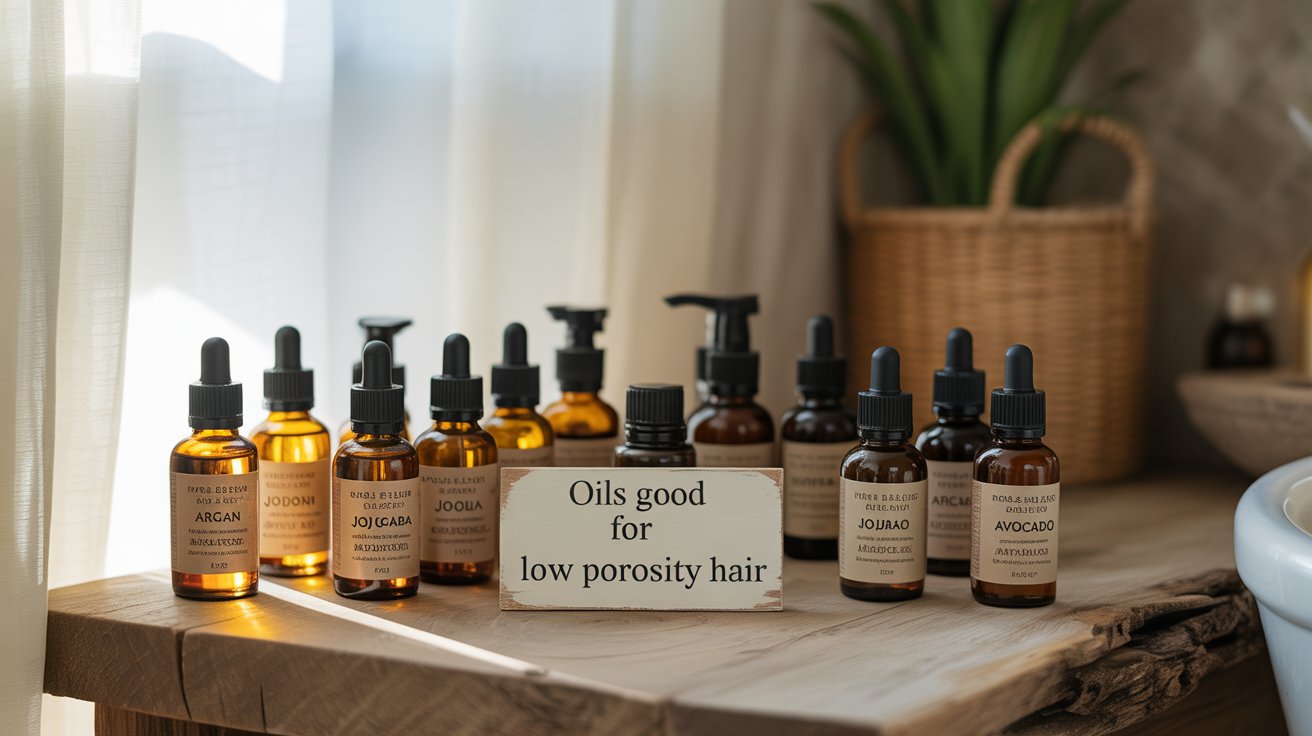Struggling to find oils good for low porosity hair? You’re not alone. Most people with low-porosity strands spend months trying product after product—only to end up with greasy buildup and zero moisture payoff.
The truth? It’s not about using more oil. It’s about using the right oils—lightweight, fast-absorbing, and proven to slip past those tightly shut cuticles.
I’ve been there: hair that repels water, conditioners that just sit on top, and oils that feel like a waxy film. Once I learned which oils actually penetrate (and which ones to avoid), everything changed—hydration lasted, frizz calmed, and styling got easier.
In this guide, I’ll break down the exact oils that work, why they work, and how to use them step-by-step—so you get real results, not just shiny buildup.
Why Low-Porosity Hair Needs a Special Oil Strategy
Low-porosity hair looks healthy on the outside—but acts stubborn on the inside. The cuticle layer lies flat and tightly shut, making it almost impossible for water and nutrients to slip in. According to the New York Society of Cosmetic Chemists (NYSCC), this closed structure slows absorption dramatically and makes hair prone to product buildup.
That’s why your conditioner feels like it’s just “sitting” on your strands. Or why heavy oils leave you greasy instead of moisturized.
Here’s the kicker: oil itself isn’t the problem. The wrong oil is. Because low-porosity hair is naturally hydrophobic, anything too heavy (like castor or coconut oil) acts like cling wrap. Instead of locking in hydration, it blocks it out.
The solution? Pick oils with light viscosity, small molecular size, and nutrient density that can slip past the cuticle barrier. That’s how you hydrate from within—without the sticky residue.
Best Oils That Penetrate & Nourish

How to Spot a Low-Porosity Friendly Oil
Not all oils are created equal. Look for:
-
Lightweight texture → won’t suffocate strands.
-
Small molecules → can pass through the cuticle.
-
High in fatty acids + vitamins → deliver actual nutrition, not just shine.
Dermatologists at the Dr. Serkan Aygin Clinic confirm that oils rich in linoleic acid and oleic acid perform best for hair that resists moisture. The Mestiza Muse echoes this, noting that molecular weight is the #1 factor that determines absorption.
Proven Oils That Work (and Why)
-
Jojoba Oil → closest match to natural sebum; balances scalp and adds lightweight moisture.
-
Argan Oil → high in vitamin E and antioxidants; smooths frizz without heaviness.
-
Grapeseed Oil → rich in linoleic acid; penetrates easily and strengthens weak cuticles.
-
Sweet Almond Oil → loaded with magnesium and proteins; softens and adds shine.
-
Apricot Kernel Oil → lightweight, fast-absorbing; perfect daily sealant.
-
Rosehip Oil → rich in vitamins A and C; improves elasticity and scalp health.
-
Sunflower Oil → natural emollient with high linoleic acid; prevents breakage.
-
Sesame Oil → antimicrobial properties; light scalp massage oil.
-
Rosemary Oil → clinically linked to supporting hair growth and circulation.
-
Avocado Oil (used sparingly) → slightly heavier, but its oleic acid content helps in deep hydration when paired with heat.
Tip: Brands like Pattern Beauty, Butter By Q, and The Holistic Enchilada consistently recommend rotating 2–3 oils instead of relying on one. This prevents buildup and keeps your hair responsive.
Read Also:
👉 Best Chebe Oil for Hair Growth
Oils to Avoid—or Use With Caution
Not every “holy grail” oil works for low-porosity hair. In fact, the wrong oil can make things worse.
Why Heavy Oils Backfire
Oils like coconut, castor, and olive may be nutrient-rich, but they’re also thick and heavy. When applied to low-porosity hair, they tend to coat the strands instead of slipping inside. Over time, that creates buildup, dullness, and even breakage—a problem highlighted by Pocket Beauty and Marie Claire.
Even if an oil like coconut can technically penetrate, its density makes it risky for regular use. The Mestiza Muse explains it well: low-porosity cuticles resist absorption, so anything with weight simply sits on the surface, suffocating your hair.
Oils & Butters to Limit
-
Coconut Oil → penetrates but too heavy for frequent use.
-
Castor Oil → great for thick hair, but clogs low-porosity strands.
-
Olive Oil → rich in nutrients, yet prone to leaving greasy buildup.
-
Shea Butter → coats instead of hydrates; better for high-porosity textures.
-
Cocoa Butter → seals too tightly, often blocking hydration.
💡 Pro Tip: If you love one of these oils, use it strategically. Apply sparingly as a pre-poo treatment, then wash thoroughly. That way you get the benefits without the long-term buildup.
Step-by-Step Routine: Getting Oil to Work for You
Here’s the truth: even the best oil won’t do much unless you use it right.
Low-porosity hair needs a hydrate → oil → seal sequence, not oil alone. Brands like Pattern Beauty and guides from Real Simple consistently stress this layered approach.
Step 1. Clarify First
Every few weeks, remove product buildup with a gentle clarifying shampoo. Experts at the Dr. Serkan Aygin Clinic note that clogged cuticles block oils from absorbing. Products like Yuiaia Haircare Clarifying Shampoo can reset your strands without stripping them dry.
Step 2. Hydrate With Water
Always start on damp hair. Spray with plain water or a water-based leave-in conditioner. Hydration comes first—oil only locks it in.
Step 3. Apply Oil Sparingly
Divide your hair into sections. Smooth a pea-sized amount of lightweight oil (jojoba, grapeseed, argan) onto the mid-lengths and ends. Avoid the scalp unless it’s a scalp-specific treatment like rosemary oil.
Step 4. Add Gentle Heat
This is the game-changer. Wrap your hair in a warm towel, or sit under a hooded dryer for 10 minutes. Heat softens the cuticle, allowing oils to penetrate. Both Pattern Beauty and Rupa Health highlight this step as essential for low-porosity hair.
Step 5. Seal If Needed
Finish with a light leave-in cream if your hair still feels dry. This keeps hydration locked in without weighing strands down.
Step 6. Adjust Your Frequency
Start with once a week. If your hair feels weighed down, pull back. If it still feels dry, increase gradually. Real Simple suggests listening to your hair instead of sticking to a rigid schedule.
With this sequence, oils stop being “greasy add-ons” and start acting like actual hydrators. Done right, even stubborn low-porosity hair drinks it up.
Expert Tips & Myth-Busters
Low-porosity hair thrives when you work with it, not against it. The best oils are lightweight, fast-absorbing, and seal without suffocating—think jojoba, argan, or aloe-based blends, as highlighted by Marie Claire.
These mimic your scalp’s natural sebum, so they sink in instead of sitting on top.
Myth #1: “Oils = Hydration”
Truth? Water = hydration. Oils only seal the moisture in once it’s already there.
Both Rupa Health and Real Simple underline this: applying oil to dry hair is like putting plastic wrap on an empty plate—nothing inside to preserve.
Always hydrate with water or a water-based leave-in first, then lock it in with oil.
Myth #2: “Protein Is Always Good”
Protein treatments get hyped as cure-alls. But for low-porosity hair, too much protein equals stiffness, brittleness, and buildup.
Experts at Marie Claire and Rupa Health warn that keratin-heavy products overwhelm the tight cuticle structure.
Save protein masks for rare “rescue” treatments, not weekly routines. Focus on lightweight oils and humectants instead.
Myth #3: “Heavier = Better Protection”
Coconut, castor, and shea may seem protective, but their weight often backfires—blocking water from entering in the first place.
Use them sparingly, if at all, and only as a pre-poo or deep treatment.
At-a-Glance Comparison Table
Here’s a cheat sheet you can scan in seconds.
| Oil Name | Benefits | How It Works (Molecule/Weight) | Best Use Frequency | Potential Caveats |
|---|---|---|---|---|
| Jojoba Oil | Mimics scalp’s sebum, light sealant | Small molecules, lightweight ester wax | 2–3x/week | Rare allergies; overuse can feel waxy |
| Argan Oil | Adds shine, softens cuticle | Rich in oleic + linoleic acid, medium-light weight | 2–3x/week | Can build up if over-applied |
| Grapeseed Oil | Lightweight seal, reduces frizz | Polyunsaturated fatty acids, very light | 3–4x/week | Minimal; may feel too light for coarse textures |
| Rosemary Oil (diluted) | Stimulates scalp circulation, supports growth | Volatile essential oil, penetrates follicles | 1–2x/week (in carrier oil) | Must dilute; may irritate sensitive skin |
| Aloe-Based Oils/Blends | Hydrates + seals simultaneously | Polysaccharides + lightweight emollients | 2–3x/week | Quality varies by brand; check ingredients |
| Coconut Oil | Penetrates shaft, reduces protein loss | Medium-chain fatty acids, heavy | Pre-poo only (occasional) | High risk of buildup on low-porosity hair |
| Castor Oil | Thick sealant, supports edges | Ricinoleic acid, very heavy | Spot use only | Greasy, clogs strands |
| Shea/Cocoa Butter | Strong occlusive layer | Large molecules, dense | Rare, protective styles only | Blocks hydration; buildup risk |
When You’re Ready to Shop: What to Look For
Not all “natural oils” are created equal. If you’ve got low-porosity hair, choosing the right product can be the difference between silky definition and heavy, greasy buildup.
Here’s how to shop smart.
Product Features That Actually Matter
Look for:
-
Lightweight blends: Jojoba, argan, grapeseed, or aloe-based oils absorb instead of sitting on the cuticle.
-
Ingredient transparency: Brands that clearly list all ingredients (avoid vague “proprietary blends”).
-
Water-based formulas: A water-first product helps moisture penetrate before oils lock it in.
Skip:
-
Silicones: They coat strands but don’t let water in.
-
Heavy butters: Shea, cocoa, and castor oil weigh down low-porosity hair unless used rarely.
Review Pointers Before You Buy
Don’t just skim star ratings—dig into the details.
-
Non-greasy feel: Real users should mention fast absorption, not “sticky” or “heavy.”
-
No hidden fillers: Watch for mineral oil, petrolatum, or unnecessary waxes.
-
Eco-friendly packaging: Recyclable glass bottles or biodegradable cartons are becoming industry standard (and signal higher-quality indie brands).
👉 Pro tip: Always spot-check reviews from platforms like Sephora, Ulta, or Target where ingredient junkies break down what works and what doesn’t.
FAQs
How often should I oil low-porosity hair?
2–3 times a week is plenty. Over-oiling leads to buildup and dullness.
Can I use coconut oil on low-porosity hair?
Only as an occasional pre-poo. It’s too heavy for daily use.
What’s the best way to test porosity?
Drop a clean strand of hair in a glass of water. If it floats, it’s likely low-porosity. If it sinks quickly, it’s high-porosity.
Conclusion
Low-porosity hair doesn’t need “more oil”—it needs the right oil. Lightweight blends like jojoba, argan, and grapeseed nourish without suffocating your strands, while water-based formulas actually help hydration sink in.
The big win? Once you match your oil to your hair’s porosity, frizz drops, definition lasts longer, and you finally get consistent results.
Start small: swap in one lightweight oil this week and track how your hair feels.
If you want a step-by-step on building a full low-porosity hair care routine, check out our [deep-dive guide to porosity-based products].
Your hair will thank you—less trial and error, more results you can actually see.

As a beauty trend analyst and style curator, Shahriar dives into the latest in style, makeup, nails, trends, and innovative product design. With a keen eye for aesthetics and an editorial background, he brings thoughtful commentary and visual inspiration to readers looking to stay ahead of beauty trends. His work focuses on making fashion-forward beauty both accessible and empowering, especially for those who love to experiment and express themselves through personal style.

